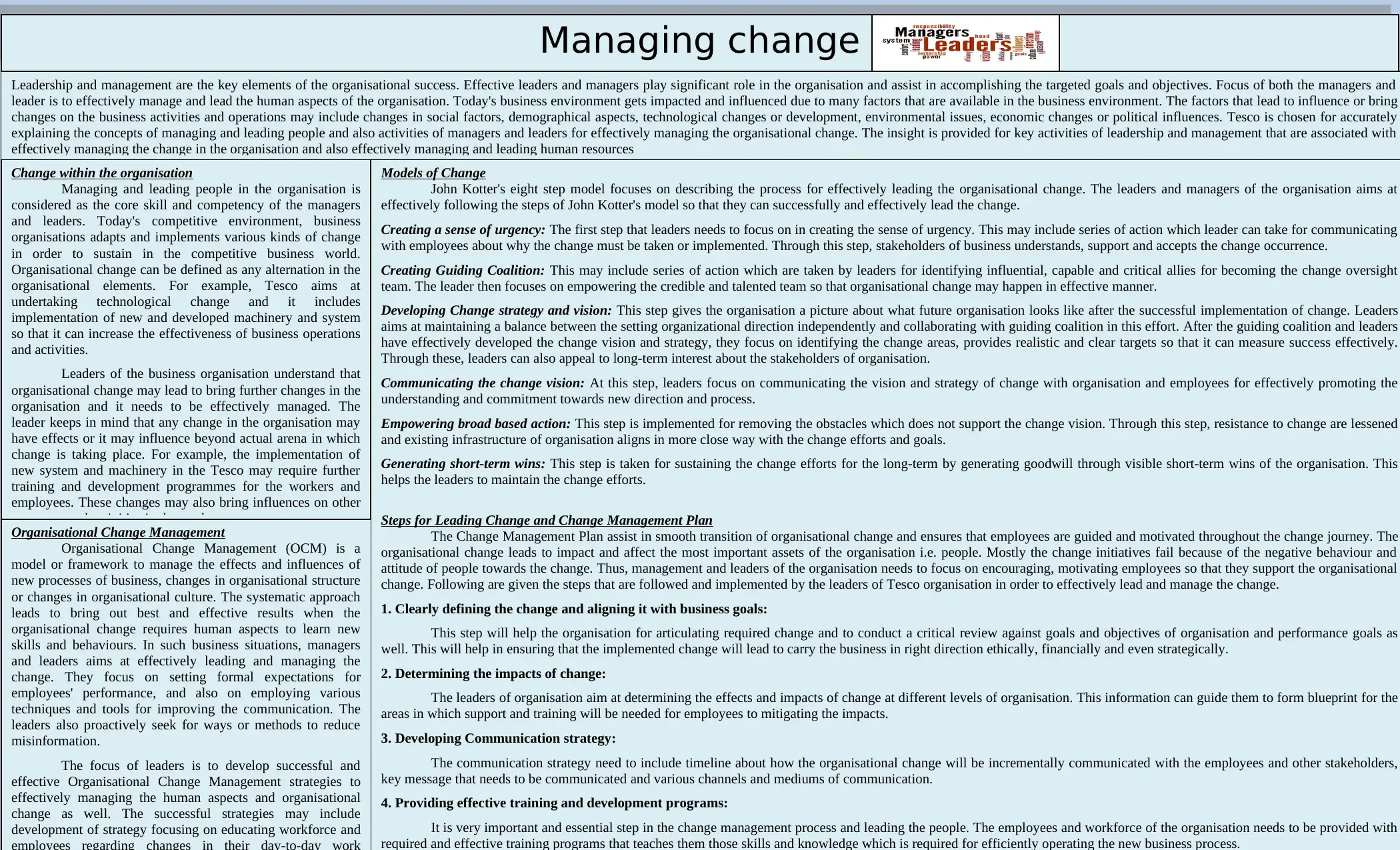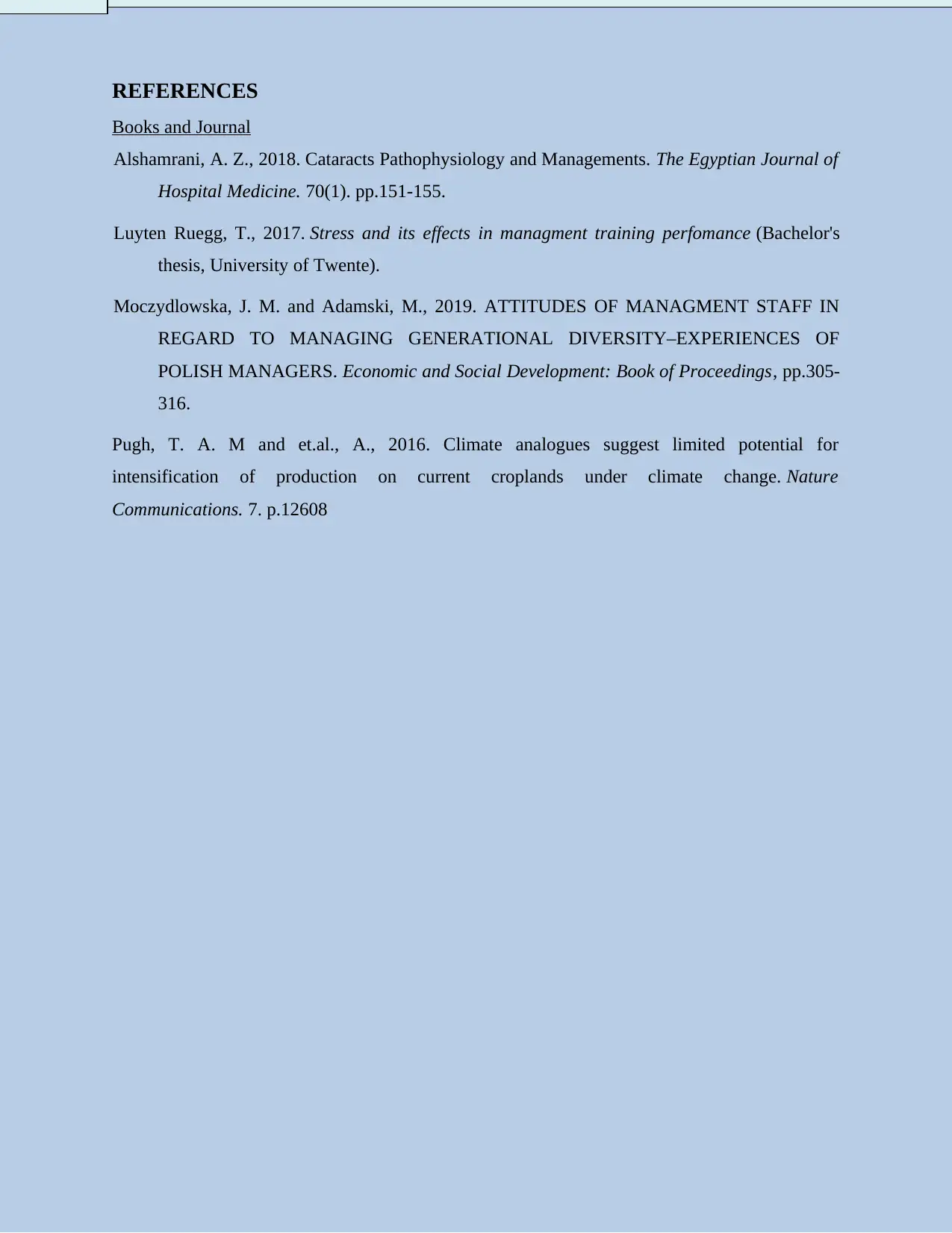Organizational Change: Kotter's Model, Tesco's Plan, and Leadership
VerifiedAdded on 2021/02/20
|4
|2874
|218
Presentation
AI Summary
This presentation delves into the intricacies of organizational change management, providing a comprehensive overview of key models and strategies. It begins by outlining John Kotter's eight-step model, a widely recognized framework for leading successful organizational change, detailing each step from creating a sense of urgency to generating short-term wins. The presentation then analyzes a change management plan, potentially implemented by Tesco, focusing on defining change, determining impacts, developing communication strategies, providing training, implementing support structures, and measuring the change process. The content further explores the critical roles of leadership and management in navigating organizational change, emphasizing the importance of managing human aspects and adapting to factors such as social, demographic, technological, environmental, economic, and political influences. Finally, the presentation defines Organizational Change Management (OCM) as a systematic approach for managing the impacts of new business processes, structural changes, and cultural shifts, with a focus on how leaders and managers can effectively guide employees through transitions and mitigate misinformation.

POSTER
PRESENTATION
PRESENTATION
Paraphrase This Document
Need a fresh take? Get an instant paraphrase of this document with our AI Paraphraser

Leadership and management are the key elements of the organisational success. Effective leaders and managers play significant role in the organisation and assist in accomplishing the targeted goals and objectives. Focus of both the managers and
leader is to effectively manage and lead the human aspects of the organisation. Today's business environment gets impacted and influenced due to many factors that are available in the business environment. The factors that lead to influence or bring
changes on the business activities and operations may include changes in social factors, demographical aspects, technological changes or development, environmental issues, economic changes or political influences. Tesco is chosen for accurately
explaining the concepts of managing and leading people and also activities of managers and leaders for effectively managing the organisational change. The insight is provided for key activities of leadership and management that are associated with
effectively managing the change in the organisation and also effectively managing and leading human resources
Change within the organisation
Managing and leading people in the organisation is
considered as the core skill and competency of the managers
and leaders. Today's competitive environment, business
organisations adapts and implements various kinds of change
in order to sustain in the competitive business world.
Organisational change can be defined as any alternation in the
organisational elements. For example, Tesco aims at
undertaking technological change and it includes
implementation of new and developed machinery and system
so that it can increase the effectiveness of business operations
and activities.
Leaders of the business organisation understand that
organisational change may lead to bring further changes in the
organisation and it needs to be effectively managed. The
leader keeps in mind that any change in the organisation may
have effects or it may influence beyond actual arena in which
change is taking place. For example, the implementation of
new system and machinery in the Tesco may require further
training and development programmes for the workers and
employees. These changes may also bring influences on other
processes and activities in the work systems.
Models of Change
John Kotter's eight step model focuses on describing the process for effectively leading the organisational change. The leaders and managers of the organisation aims at
effectively following the steps of John Kotter's model so that they can successfully and effectively lead the change.
Creating a sense of urgency: The first step that leaders needs to focus on in creating the sense of urgency. This may include series of action which leader can take for communicating
with employees about why the change must be taken or implemented. Through this step, stakeholders of business understands, support and accepts the change occurrence.
Creating Guiding Coalition: This may include series of action which are taken by leaders for identifying influential, capable and critical allies for becoming the change oversight
team. The leader then focuses on empowering the credible and talented team so that organisational change may happen in effective manner.
Developing Change strategy and vision: This step gives the organisation a picture about what future organisation looks like after the successful implementation of change. Leaders
aims at maintaining a balance between the setting organizational direction independently and collaborating with guiding coalition in this effort. After the guiding coalition and leaders
have effectively developed the change vision and strategy, they focus on identifying the change areas, provides realistic and clear targets so that it can measure success effectively.
Through these, leaders can also appeal to long-term interest about the stakeholders of organisation.
Communicating the change vision: At this step, leaders focus on communicating the vision and strategy of change with organisation and employees for effectively promoting the
understanding and commitment towards new direction and process.
Empowering broad based action: This step is implemented for removing the obstacles which does not support the change vision. Through this step, resistance to change are lessened
and existing infrastructure of organisation aligns in more close way with the change efforts and goals.
Generating short-term wins: This step is taken for sustaining the change efforts for the long-term by generating goodwill through visible short-term wins of the organisation. This
helps the leaders to maintain the change efforts.
Steps for Leading Change and Change Management Plan
The Change Management Plan assist in smooth transition of organisational change and ensures that employees are guided and motivated throughout the change journey. The
organisational change leads to impact and affect the most important assets of the organisation i.e. people. Mostly the change initiatives fail because of the negative behaviour and
attitude of people towards the change. Thus, management and leaders of the organisation needs to focus on encouraging, motivating employees so that they support the organisational
change. Following are given the steps that are followed and implemented by the leaders of Tesco organisation in order to effectively lead and manage the change.
1. Clearly defining the change and aligning it with business goals:
This step will help the organisation for articulating required change and to conduct a critical review against goals and objectives of organisation and performance goals as
well. This will help in ensuring that the implemented change will lead to carry the business in right direction ethically, financially and even strategically.
2. Determining the impacts of change:
The leaders of organisation aim at determining the effects and impacts of change at different levels of organisation. This information can guide them to form blueprint for the
areas in which support and training will be needed for employees to mitigating the impacts.
3. Developing Communication strategy:
The communication strategy need to include timeline about how the organisational change will be incrementally communicated with the employees and other stakeholders,
key message that needs to be communicated and various channels and mediums of communication.
4. Providing effective training and development programs:
It is very important and essential step in the change management process and leading the people. The employees and workforce of the organisation needs to be provided with
required and effective training programs that teaches them those skills and knowledge which is required for efficiently operating the new business process.
Managing change
Organisational Change Management
Organisational Change Management (OCM) is a
model or framework to manage the effects and influences of
new processes of business, changes in organisational structure
or changes in organisational culture. The systematic approach
leads to bring out best and effective results when the
organisational change requires human aspects to learn new
skills and behaviours. In such business situations, managers
and leaders aims at effectively leading and managing the
change. They focus on setting formal expectations for
employees' performance, and also on employing various
techniques and tools for improving the communication. The
leaders also proactively seek for ways or methods to reduce
misinformation.
The focus of leaders is to develop successful and
effective Organisational Change Management strategies to
effectively managing the human aspects and organisational
change as well. The successful strategies may include
development of strategy focusing on educating workforce and
leader is to effectively manage and lead the human aspects of the organisation. Today's business environment gets impacted and influenced due to many factors that are available in the business environment. The factors that lead to influence or bring
changes on the business activities and operations may include changes in social factors, demographical aspects, technological changes or development, environmental issues, economic changes or political influences. Tesco is chosen for accurately
explaining the concepts of managing and leading people and also activities of managers and leaders for effectively managing the organisational change. The insight is provided for key activities of leadership and management that are associated with
effectively managing the change in the organisation and also effectively managing and leading human resources
Change within the organisation
Managing and leading people in the organisation is
considered as the core skill and competency of the managers
and leaders. Today's competitive environment, business
organisations adapts and implements various kinds of change
in order to sustain in the competitive business world.
Organisational change can be defined as any alternation in the
organisational elements. For example, Tesco aims at
undertaking technological change and it includes
implementation of new and developed machinery and system
so that it can increase the effectiveness of business operations
and activities.
Leaders of the business organisation understand that
organisational change may lead to bring further changes in the
organisation and it needs to be effectively managed. The
leader keeps in mind that any change in the organisation may
have effects or it may influence beyond actual arena in which
change is taking place. For example, the implementation of
new system and machinery in the Tesco may require further
training and development programmes for the workers and
employees. These changes may also bring influences on other
processes and activities in the work systems.
Models of Change
John Kotter's eight step model focuses on describing the process for effectively leading the organisational change. The leaders and managers of the organisation aims at
effectively following the steps of John Kotter's model so that they can successfully and effectively lead the change.
Creating a sense of urgency: The first step that leaders needs to focus on in creating the sense of urgency. This may include series of action which leader can take for communicating
with employees about why the change must be taken or implemented. Through this step, stakeholders of business understands, support and accepts the change occurrence.
Creating Guiding Coalition: This may include series of action which are taken by leaders for identifying influential, capable and critical allies for becoming the change oversight
team. The leader then focuses on empowering the credible and talented team so that organisational change may happen in effective manner.
Developing Change strategy and vision: This step gives the organisation a picture about what future organisation looks like after the successful implementation of change. Leaders
aims at maintaining a balance between the setting organizational direction independently and collaborating with guiding coalition in this effort. After the guiding coalition and leaders
have effectively developed the change vision and strategy, they focus on identifying the change areas, provides realistic and clear targets so that it can measure success effectively.
Through these, leaders can also appeal to long-term interest about the stakeholders of organisation.
Communicating the change vision: At this step, leaders focus on communicating the vision and strategy of change with organisation and employees for effectively promoting the
understanding and commitment towards new direction and process.
Empowering broad based action: This step is implemented for removing the obstacles which does not support the change vision. Through this step, resistance to change are lessened
and existing infrastructure of organisation aligns in more close way with the change efforts and goals.
Generating short-term wins: This step is taken for sustaining the change efforts for the long-term by generating goodwill through visible short-term wins of the organisation. This
helps the leaders to maintain the change efforts.
Steps for Leading Change and Change Management Plan
The Change Management Plan assist in smooth transition of organisational change and ensures that employees are guided and motivated throughout the change journey. The
organisational change leads to impact and affect the most important assets of the organisation i.e. people. Mostly the change initiatives fail because of the negative behaviour and
attitude of people towards the change. Thus, management and leaders of the organisation needs to focus on encouraging, motivating employees so that they support the organisational
change. Following are given the steps that are followed and implemented by the leaders of Tesco organisation in order to effectively lead and manage the change.
1. Clearly defining the change and aligning it with business goals:
This step will help the organisation for articulating required change and to conduct a critical review against goals and objectives of organisation and performance goals as
well. This will help in ensuring that the implemented change will lead to carry the business in right direction ethically, financially and even strategically.
2. Determining the impacts of change:
The leaders of organisation aim at determining the effects and impacts of change at different levels of organisation. This information can guide them to form blueprint for the
areas in which support and training will be needed for employees to mitigating the impacts.
3. Developing Communication strategy:
The communication strategy need to include timeline about how the organisational change will be incrementally communicated with the employees and other stakeholders,
key message that needs to be communicated and various channels and mediums of communication.
4. Providing effective training and development programs:
It is very important and essential step in the change management process and leading the people. The employees and workforce of the organisation needs to be provided with
required and effective training programs that teaches them those skills and knowledge which is required for efficiently operating the new business process.
Managing change
Organisational Change Management
Organisational Change Management (OCM) is a
model or framework to manage the effects and influences of
new processes of business, changes in organisational structure
or changes in organisational culture. The systematic approach
leads to bring out best and effective results when the
organisational change requires human aspects to learn new
skills and behaviours. In such business situations, managers
and leaders aims at effectively leading and managing the
change. They focus on setting formal expectations for
employees' performance, and also on employing various
techniques and tools for improving the communication. The
leaders also proactively seek for ways or methods to reduce
misinformation.
The focus of leaders is to develop successful and
effective Organisational Change Management strategies to
effectively managing the human aspects and organisational
change as well. The successful strategies may include
development of strategy focusing on educating workforce and

REFERENCES
Books and Journal
Alshamrani, A. Z., 2018. Cataracts Pathophysiology and Managements. The Egyptian Journal of
Hospital Medicine. 70(1). pp.151-155.
Luyten Ruegg, T., 2017. Stress and its effects in managment training perfomance (Bachelor's
thesis, University of Twente).
Moczydlowska, J. M. and Adamski, M., 2019. ATTITUDES OF MANAGMENT STAFF IN
REGARD TO MANAGING GENERATIONAL DIVERSITY–EXPERIENCES OF
POLISH MANAGERS. Economic and Social Development: Book of Proceedings, pp.305-
316.
Pugh, T. A. M and et.al., A., 2016. Climate analogues suggest limited potential for
intensification of production on current croplands under climate change. Nature
Communications. 7. p.12608
Books and Journal
Alshamrani, A. Z., 2018. Cataracts Pathophysiology and Managements. The Egyptian Journal of
Hospital Medicine. 70(1). pp.151-155.
Luyten Ruegg, T., 2017. Stress and its effects in managment training perfomance (Bachelor's
thesis, University of Twente).
Moczydlowska, J. M. and Adamski, M., 2019. ATTITUDES OF MANAGMENT STAFF IN
REGARD TO MANAGING GENERATIONAL DIVERSITY–EXPERIENCES OF
POLISH MANAGERS. Economic and Social Development: Book of Proceedings, pp.305-
316.
Pugh, T. A. M and et.al., A., 2016. Climate analogues suggest limited potential for
intensification of production on current croplands under climate change. Nature
Communications. 7. p.12608
⊘ This is a preview!⊘
Do you want full access?
Subscribe today to unlock all pages.

Trusted by 1+ million students worldwide

1
1 out of 4
Related Documents
Your All-in-One AI-Powered Toolkit for Academic Success.
+13062052269
info@desklib.com
Available 24*7 on WhatsApp / Email
![[object Object]](/_next/static/media/star-bottom.7253800d.svg)
Unlock your academic potential
Copyright © 2020–2025 A2Z Services. All Rights Reserved. Developed and managed by ZUCOL.





